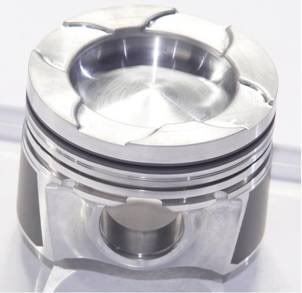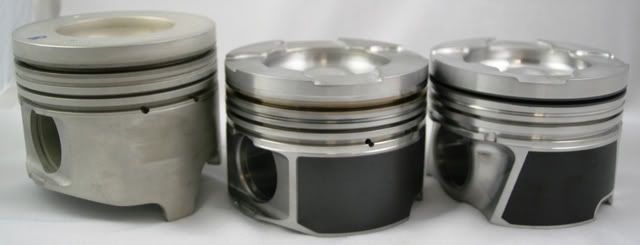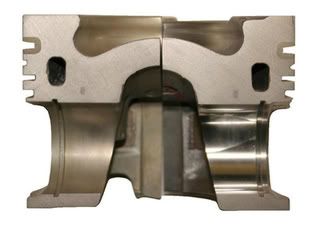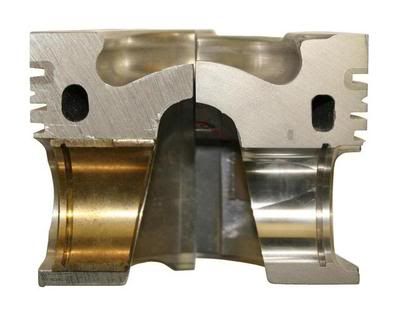Just a quick introduction so you guys know where the info's coming from; I work for Mahle Motorsports (engineering) and the diesel program falls under my responsibilities. I'll start by prefacing my comments with the disclaimer that I don't have the luxury to constantly monitor the various forums. I certainly welcome any comments, questions or further discussion, but know in advance I can't guarantee the timeliness of any replies. On the other hand, I know we have good vendors here that are active and can help seek the answers to your questions.
The main reason for chiming in here, is that I see there's still some confusion about the various types of pistons we offer. In the post below, the piston shown is actually a forged version (all other photos were correct).
The Race cast come with coating on the sides and with or without valve cut outs. There are some machine shops that say that the Race cast are weaker then the LB7 Cast pistons.
Mahle Cast Race Piston
Actual comparison of Mahle pistons:
From Left to Right: Stock replacement
cast LB7, Motorsport
cast piston, Motorsport
forged piston.
To touch briefly on the history...Mahle was the OEM supplier for the LB7 with a piston made at our facilities in Japan. Production for the aftermarket stock replacement piston was moved to a different plant in Brazil. We import this same casting for the Motorsport piston, but it is 100% machined at the Motorsport facility in Tennessee.
By starting with the raw casting, we have the flexibility to change some of the features you can't when re-cutting a finished piston.
Mahle stock replacement LB7 (L) compared to Motorsport cast (R):
GM LBZ (L) compared to Motorsport cast (R):
Compared to the LB7, and depending on the final bowl configuration, the Motorsport cast piston can be made with a 15% thicker crown, 20% more material between the bowl and the gallery, and almost 30% more material in the cross section below the pin bore (adding more inertial strength for high rpm).
But the biggest advantage is the ability to dictate the bowl design without being constrained by the parameters of a pre-cut stock bowl. Again looking at the stock LB7 for comparison:
Stock bowl = 38.1cc for 17.5:1 compression ratio (CR)
A delipped stock bowl increases volume to 40.8cc and drops compression to 16.7
With the addition of 0.075" valve pockets, volume increases to 45.5cc and compression drops to 15.4
With the Motorsport cast piston, we can alter the bowl shape and still maintain any target CR. Off the shelf, there's a 16.8:1 version that's fully delipped but also has a wider bowl diameter than the stock delipped piston. The 16.5 version has 0.075" valve pockets and maintains the same diameter as the delipped stock piston (actually +1mm) without sacrificing the compression. There's also private label versions of these pistons available with bowls that will range anywhere from 17.0 to 15.5. Custom configurations can be made with the usual stipulation that they'll cost more and take time to make.
(In case anyone notices in the comparison pictures above - there's still a remnant of the re-entrant bowl on the Motorsport piston. This was an early development sample. All current pistons are fully delipped)
When comparing the various types, the correct piston depends on the application and usage. Unfortunately, I can't assign specific HP levels to each type (it's a policy we follow regardless of gas, diesel or otherwise) because there are always the exceptions to either side of that number.
There are certainly cases where the stock or modified stock pistons make sense for various reasons (cost, availability, etc). The Motorsport cast piston was intended to offer an alternative to having to remachine stock pistons. In addition to the benefits already mentioned, we also include skirt coatings and [where applicable] fully 3D machined valve pockets that are radiused to the crown and blended with the bowl to deliver a ready-to-run part. The one feature we don't offer in-house is any form of crown coating. (Don't interpret that as a +/- opinion on crown/thermal coatings, we simply don't have the equipment).
The forged piston does offer an increase in overall strength, but you have to be willing to accept the potential risk of decreased longevity (which I've seen adequately discussed many times over, so I won't go into great detail here). However, again due to the lack of clarity between piston types, I suspect there is still some confusion between the expectations of the Motorsport cast [race] pistons and the forged [race] pistons. The best advice I can give has already been mentioned and would only like to re-enforce the plurality in "builders" to seek various opinions:
IMHO Pistons are the kryptonite of these trucks. Choose your application, do your research, talk to experienced ''builders'' on whats been working for them, then make your decision.
I apologize for the already lengthy post, but if I didn't at least mention the monotherm, I'm certain it would be the first follow-up question. What's out there today are the first prototypes for [real world] engine testing. The final design of the part won't be firmed up until we receive feedback from these tests, and even then it will take time to gear up for production, assuming all goes well. The general design of the steel parts is well proven in OEM applications and our existing Cummins part, but the material change does present some unique challenges that have to be taylored to the application. Even within the motorsport realm, I consider the Duramax design to be several steps ahead of what we've done with Cummins because of the focus on weight reduction and interchangability. Consequently, the result is more testing is required before they are released for general sales.
Murphy's Law dictates any date I mention is bound to be wrong, but we're currently targeting early to mid summer for availability.
Forged in race applications? Look harder






